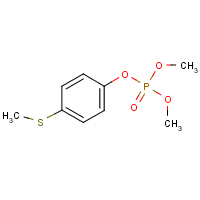Dimethyl p-(methylthio)phenyl phosphate
Agent Name
Dimethyl p-(methylthio)phenyl phosphate
CAS Number
3254-63-5
Formula
C9-H13-O4-P-S
Major Category
Pesticides

Synonyms
4-Methylthiophenyldimethyl phosphate; Allied GC-6506; Dimethyl-p-(methylthiofenyl)fosfat [Czech]; ENT 25734; Fenthion S 2145 oxon; GC 6506; HA-1200; O,O-Dimethyl O-(4-methylmercaptophenyl) phosphate; Phenol, p-(methylthio)-, dimethyl phosphate; Phosphoric acid, dimethyl 4-(methylthio)phenyl ester; Phosphoric acid, dimethyl p-(methylthio)phenyl ester; [ChemIDplus] UN3018
Category
Organophosphate Insecticides
Description
Colorless liquid; [HSDB]
Sources/Uses
Used as contact and systemic insecticide and acaricide; [HSDB]
Comments
No significant reduction in cholinesterase activity in rats fed 0.35 mg/kg for ten days; [HSDB] Highly toxic cholinesterase inhibitor; [CAMEO] “The average of two baseline respective cholinesterase activity determinations three days apart, with no exposures to enzyme inhibiting pesticides for at least 30 days, is recommended for each worker prior to exposure to cholinesterase inhibitors because of large inter-individual differences in published baseline values. To be established at least once a year. Removal from workplace exposures is recommended until the cholinesterase activity returns to within 20% of baseline.” [TLVs and BEIs]
Biomedical References
Exposure Assessment
BEI
Acetylcholinesterase activity in red blood cells = 70% of individual's baseline; Butylcholinesterase activity in serum or plasma = 60% of individual's baseline; Sample at end of shift; [TLVs and BEIs]
Explanatory Notes
The Guide in the Emergency Response Guidebook is for "Organophosphorus pesticide, liquid, toxic."
Adverse Effects
Other Poison
Organophosphate
Diseases, Processes, and Activities Linked to This Agent
Diseases
Occupational diseases associated with exposure to this agent:
Processes
Industrial Processes with risk of exposure: